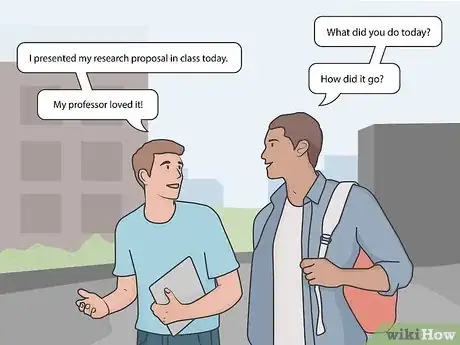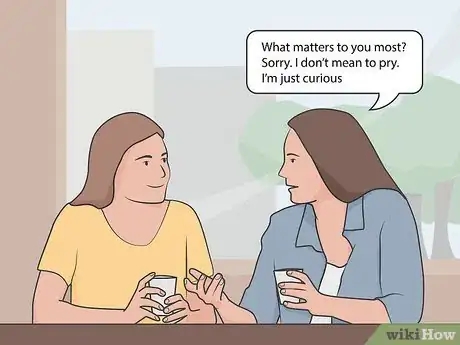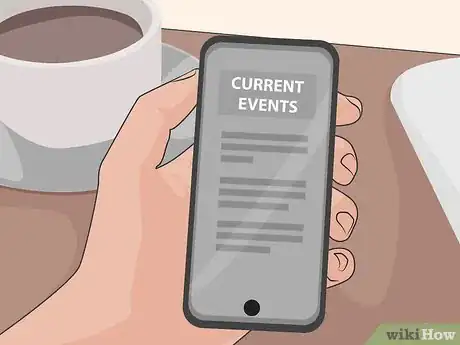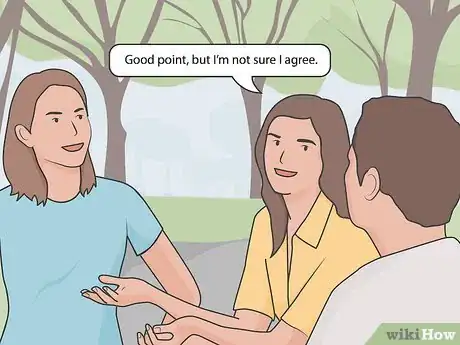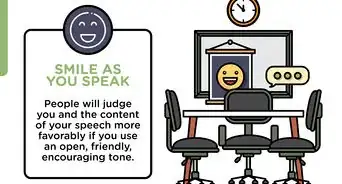This article was co-authored by Patrick Muñoz. Patrick is an internationally recognized Voice & Speech Coach, focusing on public speaking, vocal power, accent and dialects, accent reduction, voiceover, acting and speech therapy. He has worked with clients such as Penelope Cruz, Eva Longoria, and Roselyn Sanchez. He was voted LA's Favorite Voice and Dialect Coach by BACKSTAGE, is the voice and speech coach for Disney and Turner Classic Movies, and is a member of Voice and Speech Trainers Association.
wikiHow marks an article as reader-approved once it receives enough positive feedback. This article received 12 testimonials and 87% of readers who voted found it helpful, earning it our reader-approved status.
This article has been viewed 464,102 times.
Some people seem like conversational superstars, able to rattle off stories and witty jokes as if it were nothing. But if you're the quiet, or introverted type, it can seem difficult to work up the courage to speak at all. Whatever your tendency, you can learn to talk not just more, but with more substance in your words, making you a better conversationalist. Learn to start conversations and keep them going, whether you're one-on-one, in a group, or in a school setting.
Steps
Starting Conversations
-
1Lead with something you know you can both talk about. The biggest thing that keeps us from starting conversations is the fear that you'll approach someone, open your mouth, and then have absolutely nothing to say. Fortunately, there are a few easy ways that you can always be sure you'll pick something you can both talk about comfortably.[1]
- Assess the situation. If you're in class with someone, you can always start by talking about class. If you're at the same party, talk about the party. It doesn't need to be complicated: "What do you think of this neighborhood?" is even a fine way to start a conversation.
- Never try to approach a stranger and start a conversation with a pick-up line or other lame jokes. While it's not necessarily "rude," asking someone how much a polar bear weighs doesn't give you a chance to make conversation, it just gives you a lame dead-end.
-
2Remember to use good "FORM." FORM is an acronym commonly used in some conversation coaching, which helps you to remember topics that are always good for starting conversations and assorted prompts for starting them, whether you know the person well, or you're just meeting someone. It's a good rule of thumb for picking conversation starters: Family, Occupation, Recreation, and Motivation.[2]
-
Family
- "How's your mom these days?" or "How are your parents doing?"
- "How many brothers and sisters do you have?" or "Did you all get along?"
- "What was your best/worst family vacation?"
-
Occupation
- "What do you do?" or "How are you enjoying your new job?"
- "What's the toughest thing you've got going on at work?" or "What was the most interesting thing you did there this week?"
- "What are the people you work with like?"
-
Recreation
- "What do you do for fun?" or "What is there to do around here for fun?"
- "How long have you been doing that?"
- "Do you have a regular group of people you do that with?"
-
Motivation
- "What do you want to do after school?" or "Do you think you'll be at that job for long? What's your dream job?"
- "What do you want to be doing, down the road?"
Advertisement -
Family
-
3Ask open-ended questions. It's absolutely critical that you start conversations by giving people the chance to talk, and responding to them in turn. This is what makes you talkative, not the ability to chatter on about yourself. Open-ended questions give other people the opportunity to open up and give you more to respond to, and more to talk about in the conversation.[3]
- Open-ended questions can be used to follow up closed answers. If someone reticent to talk and says, "I'm doing ok, I guess" in response to your "What's up?" Say, "What did you do today?" and follow it up with, "How did it go?" Get them talking.
- Open-ended questions have to do with opinions. You can't answer an open-ended question with yes or no answers. Don't ask closed questions, like "What's your name?" or "Do you come here a lot?" This doesn't give you anything to talk about.
-
4Recall previous conversations. Sometimes, it's actually harder to talk to people you know a little bit, as opposed to strangers. If you already know someone's family history and basic story, you it's good to try to recall previous conversations to look for follow-up questions, to find out what they've been up to:
- "What'd you do today" or "What have you been up to since I've seen you?"
- "How was that project at school? Did you get it finished ok?"
- "Those pictures of vacation on Facebook looked great. How was the trip?"
-
5Practice good listening skills as well as talking. Good conversation is about more than flapping your gums. If you want to be more talkative, it's important to practice good listening and not just wait for your turn to talk.
- Make eye contact with the person, and use open body language. Nod your head when you agree and focus on the conversation.[4] Follow up with things like, "Oh, wow. Then what happened?" or "How did that turn out?"
- Really listen and respond to what the other person is saying. Practicing training yourself to paraphrase, saying, "What I'm hearing is..." and "It sounds like what you're saying is..."
- Never be more talkative by simply one-upping people in conversation, or responding to what they've said by talking about yourself all the time. Listen and respond.
-
6Read the other person's body language for clues. Some people just don't want to talk, and it won't make the situation better if you force it. Pay close attention for people who are displaying closed body language and disengage from the conversation. Focus your talkative skills on someone else instead.
- Closed body language includes things like looking over your head and around the room, as if looking for an exit. Closed or crossed arms are sometimes a sign of closed body language, as well as leaning one's shoulder toward you, or away from you.
- Open body language consists of leaning forward, making eye contact, and listen to the other person.
-
7Smile. A lot of conversation is non-verbal. People are a lot more willing to engage happy, open, friendly-looking people in conversation. You can do a lot to encourage other people in conversation and get them to engage you if you use open body language and smile.[5]
- You don't have to look like a grinning idiot, just look like you're happy to be where you are, even if you're feeling uncomfortable. No furrowed brows and sour faces. Lift your eyebrows and keep your chin up. Smile.
Having One-on-One Conversations
-
1Look for open doors in the conversation. Good conversationalists make this easy, but even with closed-off people, you can learn to find doors to open into other topics and avenues, looking for a personal connection that can give you something to really talk about together. It's kind of an art, but there are some tricks to developing it in yourself.
- Ask about someone's history with a particular subject. If someone mentions going running, ask them how long they've been running, whether or not they enjoy it, where they go running, and other associated questions.
- Ask about someone's opinion of a particular subject. If someone mentions working at Burger King during high school, ask what it was like. Solicit their opinion.
- Always be following up. There's no problem in following up someone's short answer with, "Why's that?" or "How?" Smile, to avoid seeming like you're prying, and that you're actually just curious.
-
2Don't be afraid to go deep. People like to talk about themselves, so don't be afraid of soliciting their opinions and doing a little probing into their mind. While some people who are more guarded may be reticent to talk, others will enjoy being able to share their opinion with someone who is generally curious.
- You can always back-track if you need to, and say, "Sorry, I don't mean to pry, I'm just curious."
-
3Think out loud. Don't be silent while you think of answers to questions you've been asked, just start paraphrasing what the other person has said and let yourself start talking. If you're a generally shy person, it's likely that you're overthinking what you say before you say it, and often it'll come out just as well, if not better, the less you censor yourself, and the more you just allow yourself to speak.
- Lots of people worry about "sounding dumb" or that they're going to not say the "right" thing, but this usually results in unnatural speech patterns and awkward timing in conversations. If you want to be more talkative, practice responding, even if you're not positive what you're going to say.
-
4Don't be afraid to switch topics. Sometimes, a subject will just die out, and then awkwardness can quickly set in. If you don't have anything more to say about a particular subject, don't be afraid to hop to something else, even if it doesn't necessarily follow.
- If you're having drinks and talking about football, and then football dries up, gesture to the drink and ask something like, "How is that? What's in it again?" Talk drinks for a while while you think of other subjects.
- Talk about what you want to talk about, and what you know a lot about. Things that you're very knowledgeable about are interesting to other people, at least people who are worth talking to.
-
5Stay informed about current events. If you run out of things to talk about, it's good to have a pretty good grasp of current events, common topics, and big headlines, so you can talk about something that your conversation partner is likely to have heard of, and you can find common ground.
- You don't even have to know a lot about topics to engage in conversation. Say something like, "What's the deal with this new Senate controversy? I haven't really heard specifics. Have you?"
- You don't have to be a man to fall into the "mansplaining" trap. Never assume that the person you're talking to doesn't know anything about a topic, even if it's obscure, or very specific, or it may come off as condescension.
Contributing to Group Conversations
-
1Speak louder. If you're not as talkative as you'd like to be in one-on-one conversations, talking in big groups can be an even bigger challenge. But if you want your voice to be heard, one of the most important things to learn is to speak at a volume that will allow it to be heard more easily.
- Many reticent people are also somewhat quiet, and introverted. Larger groups tend to favor extroverts and loud talkers, which means you'll have to slightly tailor your voice to the group.
- Try this: grab the floor of the conversation by raising your voice to the level of the others, but then drop to your natural speaking voice when people are listening, so you don't have to fake it. Bring them to you, not vice versa.
-
2Don't wait for a silence. Sometimes, group conversations can feel like that game Frogger: you're looking at a big street, heavy with traffic, and trying to find an opening that never comes. But the secret with that game is that you just have to dive in. Those silences, when they come, are never obvious, or expected, so it's important to risk interrupting someone, instead of waiting for absolute silence before speaking.
- Try not to interrupt people by talking over, but use interjection words before they're done, like saying, "So..." or "Wait a minute..." or even "I've got something to say," and then waiting for them to finish. You'll have grabbed the floor without talking over them completely.
-
3Make it known you want to speak with body language. If you have something to say, look at the speaker, lean forward, and use open body language that communicates you're engaged in the conversation, and want to say something. Someone may even pass you the floor by requesting your input, if you look like you want to talk.
- Sometimes, if you feel like you're getting run over by the conversation truck, it's tempting to get frustrated and disengage from the conversation. But this will only make it more difficult to talk, and will keep others from recognizing that you might want to speak.
-
4Offer alternatives. In a group setting, the conversation can quickly get boring if everyone is just saying the same thing, so it's good to play Devil's Advocate, on occasion, if the conversation calls for it. If you find yourself disagreeing with the group opinion, try gently voicing your disagreement.
- Make sure to soften disagreement by leading with, "I guess I'm seeing this a little differently, but..." or "Good point, but I'm not sure I agree."
- You don't have to adopt ideas or opinions that aren't your own just to say something, especially if you can't back it up. If you disagree though, feel free to voice it. Conversations aren't cults that punish dissent.
-
5Start a side-conversation, if necessary. Some people struggle to socialize in larger groups and flourish in one-on-one environments. There's nothing wrong with these people. A recent personality study found that many people fall into one of two groups, based on whether or not they were able to contribute to larger groups or one-on-one talks better. These groups are dyads and triads.[6]
- Dad's struggle to find purchase in larger groups. If you want to talk to someone, but struggle in a group of three or more people, take the person aside and talk. Then, talk to other people in the group one-on-one, to get into your own comfort zone. It won't seem rude if you make the time for everyone.
Talking in School
-
1Plan out a comment. Talking in class is a whole different ballgame, and what might seem awkward or unusual during informal conversations is sometimes perfectly appropriate and even expected in the classroom setting. The best example of this is group discussions, when it's perfectly appropriate to write out, or pre-plan comments that you might want to share with the class.
- In general, it can be hard to remember to bring up points you might have thought of while doing the reading in English class, or questions you had about the homework during math, so write these out and bring them up next time you're in class. Nothing wrong with a script for school.
-
2Ask a question. The best way to contribute to class is to ask questions. Any time you don't understand something, or feel like you're unclear about an issue or topic, raise your hand and ask a question. It's a rule of thumb that any time one student doesn't get it, there are probably five more who don't have the guts to raise their hand. Be the brave one.
- Only ask questions that benefit the group, or that apply to the group. It's not appropriate to raise your hand to ask, "Why did I get a B on this?"
-
3Agree with another student's comment. If you're having a group discussion and are struggling for something to say, there's usually good opportunities to piggy-back on other students comments, which has the effect of making it look like you're saying something, even if you're really not.
- Wait for someone to say something that sounds good, then chip in with, "I agree" and paraphrase it in your own words. Easy comment points.
-
4Paraphrase. Get in the habit of working things that have already been said and translating it into your own version of what was said, adding bits and pieces to it as you go. This is a great way to contribute to class without really having anything to say that wasn't already said. Of course, it's better if you add a little, to make it worth your teacher's while.
- If someone says, "I think this book is really about the family dynamics and the bad stuff they're all hiding, you know?" get your translation cap on and polish up the comment. Say, "I agree. I think you can really see the patriarchy at work in the father-son relationship displayed in this novel, especially in the downfall of the title character."
- Bonus points for pointing out specifics. Find a quotation, or a problem in your book that illustrates a point someone else has brought up.
-
5Aim for at least one contribution per class period. Generally, you don't need to be the most talkative person in your class, just talkative enough to let your presence be known. Most of the time, that means at least once per class period. This can also have the effect of keeping the teacher from picking on you later, if the rest of the class is being quiet. Plan out a point, get it out of the way, and then sit back and listen.
Expert Q&A
Did you know you can get expert answers for this article?
Unlock expert answers by supporting wikiHow
-
QuestionHow do I stop being so quiet?
 Patrick MuñozPatrick is an internationally recognized Voice & Speech Coach, focusing on public speaking, vocal power, accent and dialects, accent reduction, voiceover, acting and speech therapy. He has worked with clients such as Penelope Cruz, Eva Longoria, and Roselyn Sanchez. He was voted LA's Favorite Voice and Dialect Coach by BACKSTAGE, is the voice and speech coach for Disney and Turner Classic Movies, and is a member of Voice and Speech Trainers Association.
Patrick MuñozPatrick is an internationally recognized Voice & Speech Coach, focusing on public speaking, vocal power, accent and dialects, accent reduction, voiceover, acting and speech therapy. He has worked with clients such as Penelope Cruz, Eva Longoria, and Roselyn Sanchez. He was voted LA's Favorite Voice and Dialect Coach by BACKSTAGE, is the voice and speech coach for Disney and Turner Classic Movies, and is a member of Voice and Speech Trainers Association.
Speech Coach If you're naturally really quiet, it can take practice to learn to use your voice. When you're learning to speak more loudly, it can feel more comfortable to talk to someone you don't know. Try ordering your coffee in a loud, strong voice, for instance, or put your phone on speaker and move it further away from you so you have to talk a little louder. If that doesn't work, consider going to a voice and speech coach for training on how to use your breathing to develop your voice.
If you're naturally really quiet, it can take practice to learn to use your voice. When you're learning to speak more loudly, it can feel more comfortable to talk to someone you don't know. Try ordering your coffee in a loud, strong voice, for instance, or put your phone on speaker and move it further away from you so you have to talk a little louder. If that doesn't work, consider going to a voice and speech coach for training on how to use your breathing to develop your voice. -
QuestionHow can I make a silent person talk more?
 Community AnswerIf you have to find ways to make them talk, they probably don't want to talk -- don't force it. But, if you really must, try asking them simple questions. A simple "how are you?" is not only a good starter, but it can also show you if they are willing to talk more. And instead of asking "What do you like to do for fun?" be more specific and ask something like, "Do you like sports/music?"
Community AnswerIf you have to find ways to make them talk, they probably don't want to talk -- don't force it. But, if you really must, try asking them simple questions. A simple "how are you?" is not only a good starter, but it can also show you if they are willing to talk more. And instead of asking "What do you like to do for fun?" be more specific and ask something like, "Do you like sports/music?" -
QuestionI have practiced, but I am still shy. What should I do?
 Community AnswerDon't think about what you are going to say. Overthinking will make you worry about messing up and you will come off as odd or stilted. Just say what you want/need to say and keep the conversational ball rolling from there.
Community AnswerDon't think about what you are going to say. Overthinking will make you worry about messing up and you will come off as odd or stilted. Just say what you want/need to say and keep the conversational ball rolling from there.
Warnings
- Do not talk to people who seem really unfriendly, just to prove to yourself you are talkative; they could be nice but maybe not.⧼thumbs_response⧽
- If you are an introvert, and enjoy being on your own -- don't try to change yourself much. Just do what fits your nature.⧼thumbs_response⧽
- Quiet people and introverts shouldn't try to change themselves just based on these suggestions.⧼thumbs_response⧽
References
- ↑ https://books.google.com.ph/books?hl=en&lr=&id=kGDSyLfS6tMC&oi=fnd&pg=PT12&dq=start+a+conversation+&ots=S7jDBaU6vs&sig=2CK8Ner6uA06Gk4v0WwPiSTcVEQ&redir_esc=y#v=onepage&q&f=false
- ↑ https://www.psychologistworld.com/behavior/interpersonal-skills/smalltalk-conversation-form-technique
- ↑ https://hbr.org/2018/05/the-surprising-power-of-questions
- ↑ https://www.helpguide.org/articles/relationships-communication/effective-communication.htm
- ↑ https://www.education.vic.gov.au/childhood/professionals/learning/ecliteracy/interactingwithothers/Pages/conversationandsocialskills.aspx
- ↑ https://link.springer.com/article/10.3758/s13423-020-01821-9
About This Article
To be more talkative, ask people questions about things that most people enjoy talking about, like their family, their job, and their hobbies. For example, you could ask "How many siblings do you have? Are you close with them?" or "What do you usually do on the weekends?" When you're having a conversation with someone, try to just say whatever comes to your mind without overthinking it, which will make it easier to have a natural conversation. To learn how to be more talkative when you're with a group, scroll down!


